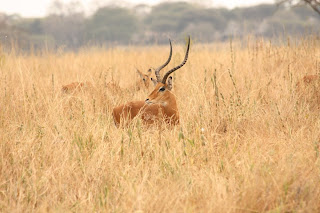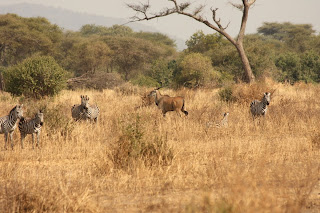 |
We saw lots of antelopes throughout our journey, and it was sometimes difficult to remember which type was which, so here's a quick primer for you to refer to when viewing all the pictures. Impalas (above, left) have curved lyre shaped horns which bend both right/left and forward/back, while gazelles (above right) have straighter ones. We saw two types of gazelles, the smaller Thomson's Gazelles, and the larger Grant's Gazelle. The picture above shows a Grant's Gazelle, whose horns are curved more than the Thomson's. Thomson's Gazelles have a characteristic black stripe on their sides, which isn't found on the impalas, but is sometimes found on the Grant's Gazelles. The Grant's Gazelles, which don't always have the stripe, have a white rump which extends up beyond the tail. Additionally, female gazelles have horns, while female impala do not. Now, based on what you've just learned, what is this:

Yes, it's a bit confusing, as its got no stripe, but the white on the rump stops at the tail, and the horns are straight. My best guess is that this is a young male impala, whose horns haven't taken on their full adult shape yet. I make this guess from additional knowledge of the pictures taken at the same time, showing a bunch of females without horns, which must be impalas (I think).
Easier to tell apart are the Eland (below right, standing amidst the zebras), the largest antelope, and the Dik-dik (below left), the smallest of the antelopes.
 |  |
2 comments:
Glad you're back! What happened to the archive material from MPotD though? I wanted to show a friend your timelapse of the party setup, but your old site is showing up as "forbidden" at CTIO.
Keep up the postings. I love reading your travelogs.
Alas, the old CTIO webpages seem to have been taken down. I do have backups of all the pages on DVD and my local hard drive, but I haven't figured out yet where to host them from. I'll let you know when they get back up, and where to find them.
Post a Comment